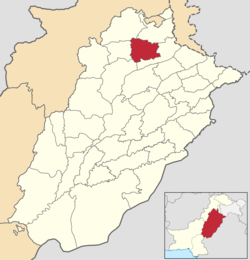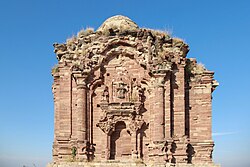Chakwal District
Chakwal
ضلع چکوال | |
|---|---|
 Chakwal is located in the north of Punjab. | |
| Coordinates:33°40′38″N72°51′21″E/ 33.67722°N 72.85583°E | |
| Country | |
| Province | |
| Division | Rawalpindi |
| Headquarters | Chakwal |
| Tehsils(3) | |
| Government | |
| • Type | District Administration |
| •Deputy Commissioner | Quratulain Malik(PAS) |
| • District Police Officer | Capt. (R) Wahid Mehmood |
| • District Health Officer | Dr. Anjum Qadeer |
| Area | |
| • Total | 3,593 km2(1,387 sq mi) |
| Population (2023)[1] | |
| • Total | 173,854 |
| • Density | 265.88/km2(688.6/sq mi) |
| Time zone | UTC+5(PST) |
| Main language(s) | Punjabi |
| Website | chakwal |
Chakwal District(PunjabiandUrdu:ضلع چکوال) is inPothohar PlateauofPunjab,Pakistan. It is located in the north of the Punjab province, Chakwal district is bordered byTalagangto its south,Rawalpindito its north east,Jhelumto its east,TalagangThe district was created out of parts of Jhelum and Attock in 1985.[2]
History
[edit]DuringBritish rule,Chakwal was a tehsil of Jhelum district, the population according to the 1891 census of India was 164,912 which had fallen to 160,316 in 1901. It contained the towns of Chakwal andBhaunand 248 villages. The land revenue andcessesamounted in 1903-4 to 3–300,000.[3]The predominantly Muslim population supportedMuslim LeagueandPakistan Movement.After theindependenceof Pakistan in 1947, the minorityHindusandSikhsmigrated to India while theMuslimsrefugees from India settled down in the area of Chakwal later it was upgraded as a District on 1 July 1985.
Administrative divisions
[edit]The district of Chakwal, which covers an area of 6,524 km2,is subdivided into fivetehsils.[4]These tehsils were formerly part of neighbouring districts:[5]: 1
- Chakwal Tehsilwas annexed fromJhelum Districtand made part of the newly formed Chakwal District.
- Choa Saidan Shahwas carved out of sub-divisionPind Dadan Khanof Jhelum District and was amalgamated with sub-divisionChakwal.Choa Saidan Shah was upgraded to the level of a sub-division in 1993.
Now the district is administratively subdivided into Five tehsils and 71union councils.[6]
| Name of tehsil | No. of union councils | No. of villages | No. of public schools | No. of police stations | No. of post offices | Parent tehsil |
|---|---|---|---|---|---|---|
| Chakwal[4] | 30 | 207 | 485 | 5 | 48 | Chakwal |
| Choa Saidan Shah[4] | 7 | 47 | 93 | 1 | 14 | Chakwal |
| Kallar Kahar[4] | 8 | 72 | 146 | 1 | 15 | Chakwal[4] |
| Lawa | 5 | 5 | 116 | 1 | 3 | Talagang |
| Talagang | 19 | 75 | 300 | 1 | 12 | |
| Total | 45 | 326 | 1140 | 7 | 77 |
Constituencies
[edit]There is one district council, one municipal committees —Chakwal— and two town committees —Choa Saidan ShahandKallar Kahar.
The district is represented in theNational Assemblyby two constituencies: NA-60 and NA-61. The district is represented in theprovincial assemblyby four elected MPAs and in National Assembly by two MNAs who represent the following constituencies:[7]
Geography
[edit]Chakwal district borders the districts ofRawalpindiandAttockin the north,Jhelumin the east,Khushabin the south andMianwaliin the west. The total area of Chakwal district is 6,609 square kilometres, which is equivalent to 1,652,443 acres (6,687.20 km2).
The southern portion runs up into the Salt Range and includes the Chail peak, 3,701 feet (1,128 m) above the sea, the highest point in the district. Between this and the Sohan river, which follows more or less the northern boundary, the country consists of what was once a fairly level plain, sloping down from 2,000 feet (610 m) at the foot of the hills to 1,400 feet (430 m) in the neighbourhood of the Sohan; the surface is now much cut up by ravines and is very difficult to travel over.[3]
Demography
[edit]At the time of the digital census 2023, Chakwal district had 288,838 households and a population of 1,734,854 with average growth rate 2.51% with respect to Census 2017. Chakwal had a sex ratio of 99.23 female to 100 male and a literacy rate of 77.79% - 86.12% for males and 69.52% for females. 434,805 (25.06%) lived in urban areas. 398,401 (22.96%) were under 10 years of age.Muslimsformed the overwhelming majority at 1,722,147 (99.45%) while 9,542 (0.55%) were from religious minorities, mainly Christians.[1]
At the time of the 2023 census, 92.04% of the population spokePunjabi,5.47%Pashtoand 1.66%Urduas their first language.[1]
The local Punjabi dialects areDhani[11]andAwankari.[12]
Education
[edit]Chakwal has a total of 1,140 government schools out of which 52.63% (600 schools) are for female students. The district has an enrollment of 181,574 in public sector schools.[13]
Educational institutions
[edit]Notable Educational institutions in the Chakwal District include:
- Government Post Graduate College (Chakwal)
- University Of Chakwal
- Govt. High School No.1, Chakwal
- Govt. Girls High School No.1, Chakwal
- Govt. Islamia High School, Chakwal
Notable people
[edit]- Yahya Khan,former President of Pakistan, was born in Chakwal city in 1917.
- Manmohan Singh,former Prime Minister of India, was born in Gah village (formerly part ofJhelum District)
- Khudadad KhanVC,British Indian Army, operated a machine gun despite being wounded after his team was overrun and bayoneted by the Germans, holding them back long enough for reinforcements in theWestern Front
- Nur Khan,was a three-star air officer, politician, sports administrator, and the Commander-in-Chief of the Pakistan Air Force, serving under President Ayub Khan from 1965 until 1969.
- Tajammul Hussain Malik,War Hero of theIndo-Pakistani War of 1965,held an impenetrable defence in theBattle of Hilliagainst a multiple times larger force and famously refused to surrender vowing to fight till the end
- Muhammad Safdar,Lt. General Muhammad Safdar is the former Governor of Punjab, having served from 1999 to 2001. He has also previously served as the ambassador to Morocco and the Vice-Chancellor of the University of Punjab until 1993.
- Colonel Imam– BrigadierSultan Amir Tararwas aone-starrankarmy generalin thePakistan Army,member of theSpecial Service Group(SSG) of the army, and anintelligence officerof theInter-Services Intelligence(ISI).
- Rafiuddin Hashmi,an Iqbalist, researcher, travel writer and a professor inOriental College,and theUniversity of the Punjab
- Sukh Devis,an Indianorganic chemist,academic, researcher and writer, known for his contributions in the development ofGuggulsterone,a plant-derived steroid used as a therapeutic and nutritional agent.
See also
[edit]References
[edit]- ^abc"Pakistan Digital Census 2023 - Detailed Results".Pakistan Bereau of Statistics - Government of Pakistan.25 July 2024.Retrieved25 July2024.
- ^"Chakwal Tehsils".Punjab Portal, Punjab Government website.Archived fromthe originalon 20 December 2016.Retrieved27 January2023.
- ^abImperial Gazetteer of India, v. 10, p. 126Digital South Asia Library, University of Chicago website, Retrieved 27 January 2023
- ^abcde"List of Tehsils and Districts".Population Census Organization, Government of Pakistan website.Archived fromthe originalon 1 January 2007.Retrieved27 January2023.
- ^1998 District Census report of Chakwal.Census publication. Vol. 77. Islamabad: Population Census Organization, Statistics Division, Government of Pakistan. 2000.
- ^"Tehsils & Unions in the District of Chakwal".National Reconstruction Bureau, Government of Pakistan website.Archived fromthe originalon 24 January 2008.Retrieved27 January2023.
- ^"CHAKWAL Constituancies (PP-20 to PP-23)".Provincial Assembly of the Punjab website.Archived fromthe originalon 20 June 2008.Retrieved27 January2023.
- ^"PML-N wins Chakwal by-polls with thumping majority".The News International (newspaper).10 January 2018.Retrieved27 January2023.
- ^Nabeel Anwar Dhakku,"Chakwal district falls into PML-N's fold",Dawn (newspaper),retrieved27 January2023
- ^"District Wise Results / Tables (Census - 2023)"(PDF).www.pbscensus.gov.pk.Pakistan Bureau of Statistics.
- ^Masica, Colon P. (9 September 1993).The Indo-Aryan Languages.Cambridge University Press.p. 19.ISBN0521299446.
- ^Rensch, Calvin R. (1992). "The Language Environment of Hindko-Speaking People". In O'Leary, Clare F.; Rensch, Calvin R.; Hallberg, Calinda E. (eds.).Hindko and Gujari.Sociolinguistic Survey of Northern Pakistan. Islamabad: National Institute of Pakistan Studies, Quaid-i-Azam University and Summer Institute of Linguistics. p. 7.ISBN969-8023-13-5.
- ^"Statistics for District Chakwal, Punjab Annual Schools Census Data 2014-15".School Education Department, Punjab Government website.Archived fromthe originalon 22 August 2016.Retrieved27 January2023.
Bibliography
[edit]- University of Engineering and Technology. Centre of Excellence in Water Resources Engineering; Pakistan Science Foundation (1979),National Seminar on Land and Water Resources Development of Barani Areas, [July 21-24, 1979],The University of Wisconsin,ISBN978-01-9023-806-3
External links
[edit]"Official Website of Chakwal District".Archived fromthe originalon 3 July 2009.Retrieved27 January2023.




